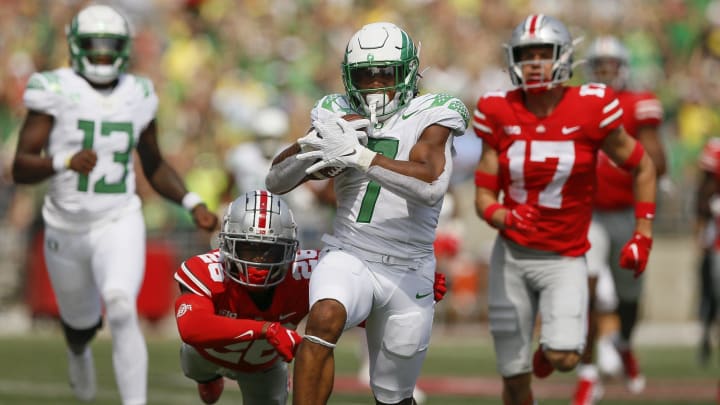Big Ten Open To Moving Conference Title Game To West Coast?

Big Ten Conference Commissioner, Tony Petitti, kicked off the Big Ten’s Media week at Lucas Oil Stadium with prepared remarks and then fielded questions from a variety of sports reporters on topics ranging from travel, schedules, broadcast partners, NIL, the growing footprint of the Big Ten, the likelihood of more expansion and league realignment.
The travel issue has been a hot topic starting with the announcement that UCLA and USC were leaving the Pac-12 to join the Big Ten. The debate heated up further when the Oregon Ducks and Washington also bolted from the crumbling Pac-12 conference. The conversation has centered mostly on football given the fact that teams play one game per week which does not allow for multiple contests on the same trip.
The four new Big Ten teams will travel farther than any other Big Ten team during the regular season. UCLA leads the list with approximately 22,048 miles, followed by Washington, 17,522 miles, USC at 12,710 miles and Oregon at 12,520 miles. Time will tell whether these teams will face more adversity with such a travel schedule or will coaches like Oregon’s Dan Lanning find ways to minimize the impact of the travel for these student-athletes.
Petitti also took advantage of the spotlight to announce that the Big Ten and Lucas Oil Stadium have agreed to extend their relationship regarding the venue for a conference championship game through the 2028 season. During the question-and-answer period, Petitti was asked about the possibility of moving the game to west coast venues such as Las Vegas and/or Los Angeles.
“Given the footprint of the conference, the cities that are now interested in hosting a Big Ten championship have clearly expanded,” said Petitti. “We are really comfortable with the decision to stay (here) in Indianapolis for the next four seasons. We think it’s the right thing to do.”
He went on to discuss the possibility of moving the game once the agreement with Lucas Oil ends.
“It’s really important to make sure that markets around the country get to experience Big Ten Championships,” added Petitti. “It’s really a good way to connect the conference. I think over time you will start to see the geographic footprint expand. You will start to see the footprint of how we host championships change and grow.”
Petitti also spent time talking about the expanded media coverage and game telecasts moving forward. He noted that Big Ten games will now be seen Friday nights and Saturday at 12noon (eastern) on Fox, 3:30pm on CBS and NBC at 7:30pm. In addition, the Big Ten network, FS1 and Peacock will also televise games. All in, he claimed that the Big Ten will have 60 network broadcasts in the upcoming season, the most of any conference.
Given that Friday nights have traditionally been reserved for high school sports, Petitti was asked about the potential benefits of playing on Friday.
“I think Friday is an opportunity for national exposure,” said Petitti. “So you are going to see some programs really embrace the opportunity to play on Friday. Of course, we don’t want to burden any one institution, but if you look at it, it’s an opportunity to get programs to showcase them as they build.”
While playing on Friday does offer some benefits, there are scheduling pitfalls as well, something the league as a whole needs to address.
Oregon plays two Friday games in 2024: Against Michigan State on October 4th and at Purdue on October 18th.
“It’s a league discussion that involves all 18 teams about the best way to format our schedule,” said Petitti. “Collectively, we all understand we are doing this together and we’ve got to make every telecast opportunity work for the conference to be as strong and healthy as we can.”
In many ways, the upcoming season will be filled with unknowns. Those teams that can adapt quickly to changing situations are likely the ones headed for conference championships and the college football playoffs. After all is said and done, it’s still football and focusing on what you can control is important, maybe more so now than ever before.
